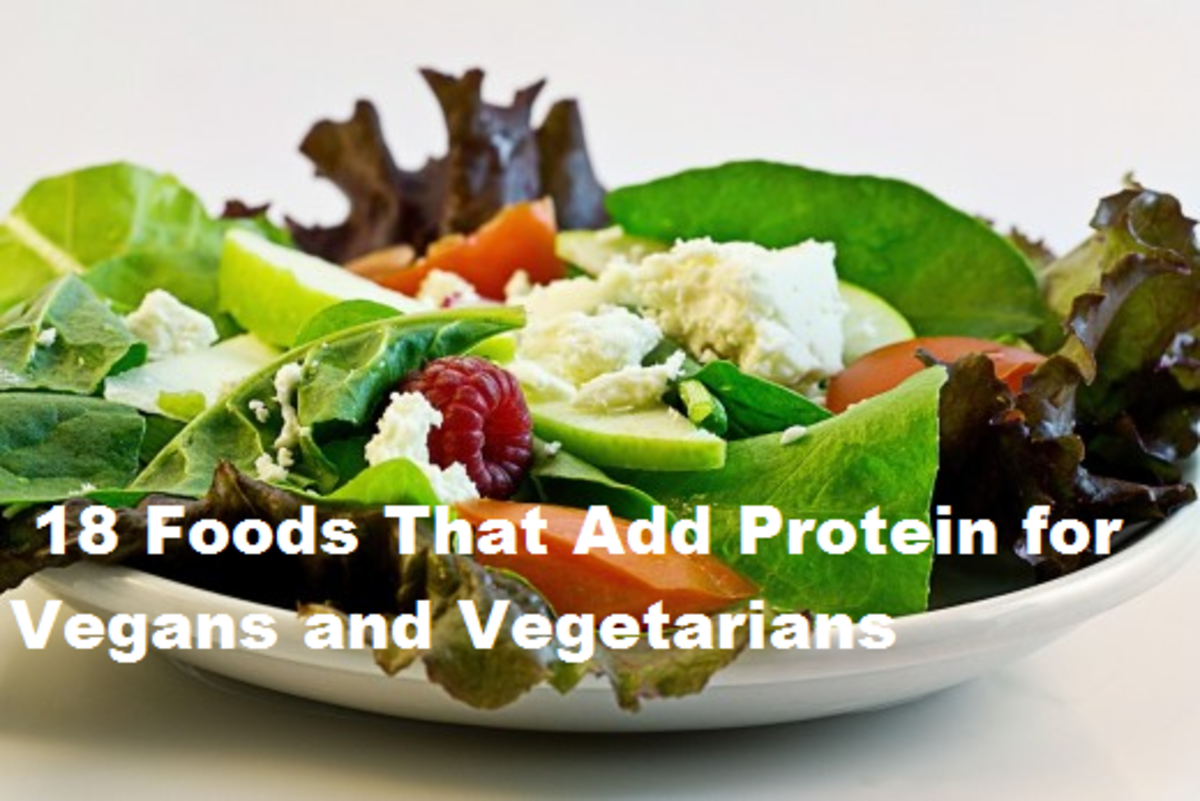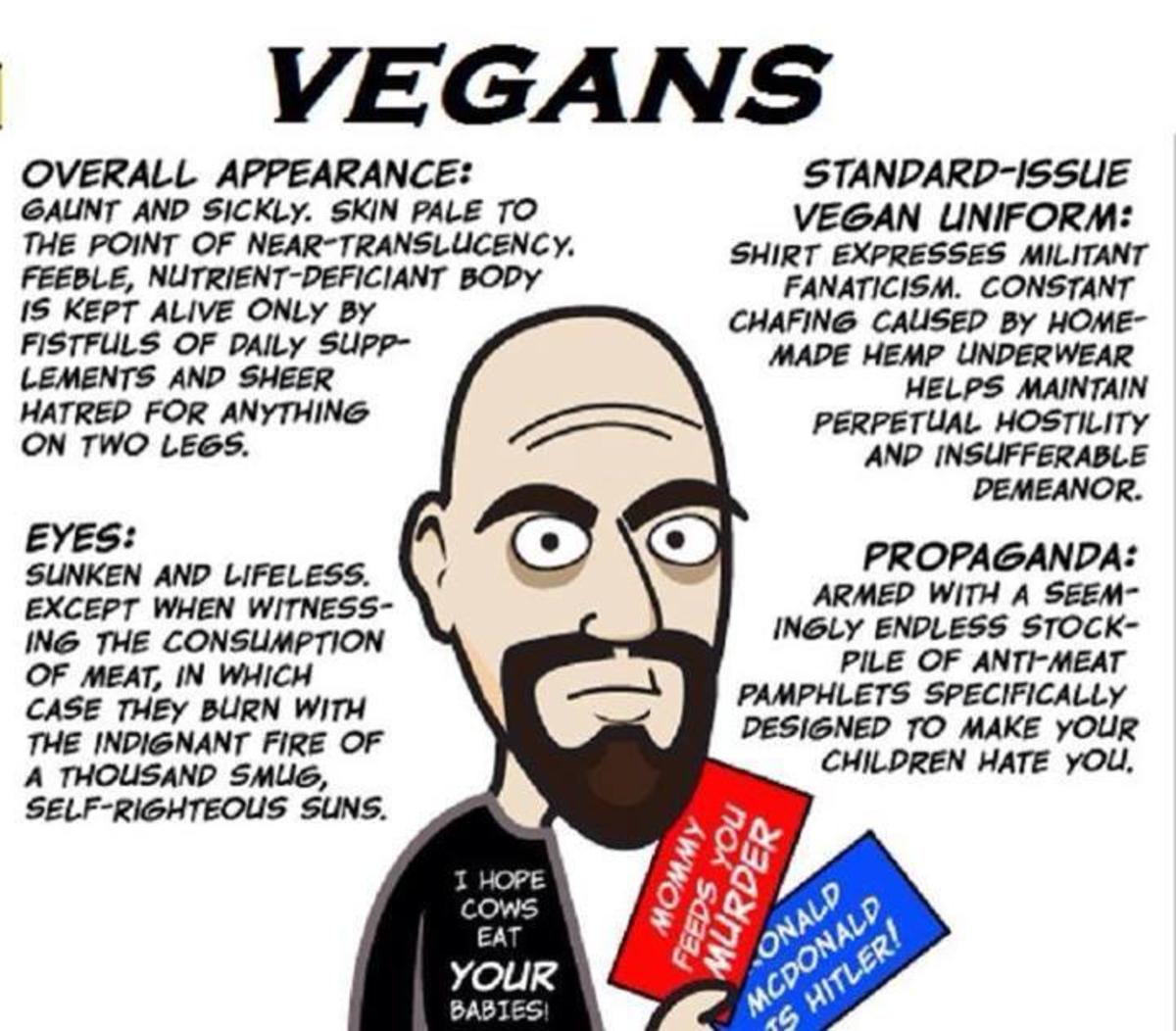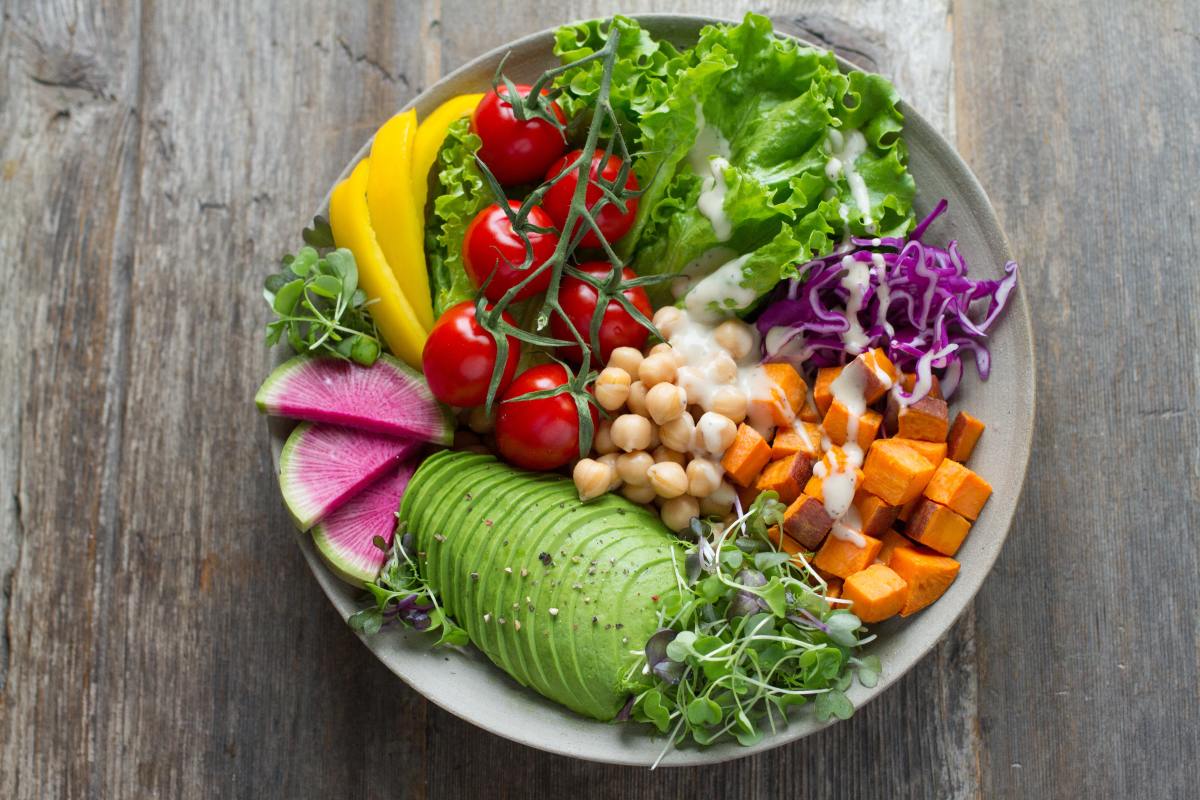MyPlate for Vegetarians
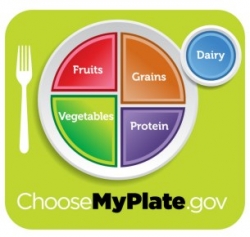
The New MyPlate.gov Offers Vegetarian Choices
The new food representation guide, MyPlate released in June 2011 offers something that the old MyPyramid did not, namely food choices and information for vegetarians.
The MyPlate is designed to remind Americans to eat healthfully using an easier to visualize method of eating. Using the familiar place setting,
MyPlate at ChooseMyPlate.gov shows the five basic food groups arranged on a plate with a beverage for quick and easy portion control.
Criticized in the past for not including vegetarians with the 2005 MyPyramid update, with this redesign of MyPlate, the USDA included a section of information devoted to Vegetarian Diets in their main Tips and Resources section along with a Vegetarian Resource list.
After nearly 20 years of using the pyramid, the USDA may have gotten it right with the plate. According to a Wall Street Journal Poll comparing the food pyramid with the food plate voters are overwhelmingly prefer the plate to the pyramid.
Defining Vegetarian
Someone living on a diet of grains, pulses [legumes], nuts, seeds, vegetables and fruits with or without the use of dairy products and eggs.
A vegetarian does not eat any meat, poultry, game, fish, shellfish or slaughter by-products.
Types of Vegetarians
There are many different subtypes types of Vegetarians from those who do not consume any dairy or eggs to those who consume varying levels of dairy, eggs and some meats.
- Lacto-ovo-Vegetarian
A lacto ovo vegetarian eats dairy products and eggs, but does not eat meat, fish or poultry.
- Lacto-Vegetarian
A lacto vegetarian eats dairy products but not eggs, meat, fish or poultry
- Ovo-Vegetarian
An ovo vegetarian eats eggs but not dairy products, meat, fish or poultry.
- Semi-Vegetarian
A semi vegetarian eats a diet that is primarily made up of vegetables, fruits, grains, legumes, seeds, nuts, dairy and eggs along with fish, a small amount of poultry, but no meat.
- Pesci-Vegetarian
A pesci vegetarian eats a diet that is primarily made up of vegetables, fruits, grains, legumes, seeds, nuts, dairy and eggs along with fish and no poultry or meat.
- Vegan
A vegan eats a diet made up of vegetables, fruits, grains, legumes, seeds and nuts, but does not eat any products derived from animals—no meat, fish, dairy or eggs.
MyPlate for Vegetarians
The New MyPlate.gov
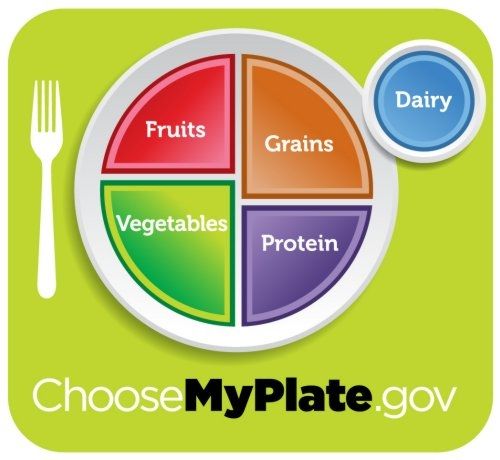
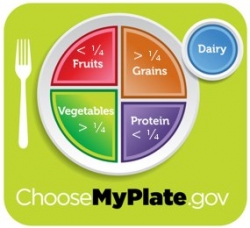
Eating Vetegarian with MyPlate
Using the new MyPlate is a quick and simple method to help get foods in the right groups and also with portion control .
Start with a 9 inch plate, then divide up the plate you are eating on into roughly four quadrants. Fill up each of the quadrants with one of the food groups.
Vegetables and Grains should be a bit more than 1/4 of the plate, where as fruits and proteins a bit less than 1/4 of the plate.
To make it a vegetarian plate, simply fill up your plate with vegetarian options for the proteins like beans, nuts, seeds and processed soy products.
Modified MyPlate to include recommended amounts
Key Tips from the New MyPlate
These are the key health messages that health consumers are being encouraged to follow with the new MyPlate to help them eating healthier diets.
- Balance Calories
Enjoy your food, but eat less.
Avoid oversized portions.
- Foods to Increase
Make half your plate fruits and vegetables.
Switch to fat-free or low-fat (1%) milk.
Make at least half your grains whole grains
- Foods to Reduce
Compare sodium (salt) in foods like soup, bread, and frozen meals, and choose foods with lower numbers.
Drink water instead of sugary drinks.
Helping the Family to Eat Proper Portions
Parents don't have the time to measure out exactly three ounces of chicken... But we do have time to take a look at our kids' plates. We do it all the time. We usually are the ones fixing the plates.
And as long as they're eating proper portions, as long as half of their meal is fruits and vegetables alongside their lean proteins, whole grains and low-fat dairy, then we're good.
It's as simple as that.
Michelle Obama
More from MyPlate.gov
These are links to additional available resources on the ChooseMyPlate.gov site.
- USDA's MyPlate - Home page
ChooseMyPlate.gov is the home page for the USDA's MyPlate -- the federal government's nutrition education and guidance. - USDA's MyPlate.gov - Vegetarian Diets
Vegetarian diets can meet all the recommendations for nutrients. The key is to consume a variety of foods and the right amount of foods to meet your calorie needs. - Vegetarian Nutrition Resource List
PDF File from the Food and Nutrition Information Center at the National Agricultural Library. - My Plate on Twitter
Follow ChooseMyPlate.gov (@MyPlate) on Twitter. #MyPlate is a quick, simple reminder to help people think about food choices to lead healthier lifestyles. - Flickr: What is on MyPlate?
We want to see where and when you think about healthy eating. Join us in Take the Plate. Print MyPlate or display on a mobile device and snap a photograph to show how and where you choose the best foods to put on your plates when building a healthy m - USDA (U.S. Department of Agriculture) on Youtube
USDA Office of Communications - Our mission is to provide leadership, expertise, counsel and coordination for the development of communications strategies which are vital to the overall formulation, awareness and acceptance of U.S. Department of Agri
Learning about MyPlate
The emphasis of the new plate is on filling half of the plate with fruit and vegetables. A clip from a fast-paced and entertaining program that conforms with the newest USDA Dietary Guidelines for Americans and the MyPlate from HumanRelationsMedia.
Five Food Groups and Serving Sizes
The food plate, like the food pyramid, has been divided into five food groups. People are encourage to eat from each of the five food groups every daily to ensure that they have a balanced diet.
For vegetarians, the main thing that needs to be changed is their choice of protein sources. Vegetarian protein options include legumes, beans and peas, processed soy products, nuts and seeds.
- Grain Group - Make half of your grains whole.
A Grain Serving equals:
- 1 slice of bread
1/2 cup cooked cereal, rice or pasta
1 oz. ready-to-eat cereal
1/2 bun, bagel or English muffin
1 small roll, biscuit or muffin
3-4 small crackers
- Vegetable Group - Vary your Veggies.
A Vegetable Serving equals:
- 1/2 cup cooked or raw vegetables
1 cup leafy raw vegetables
1/2 cooked legumes (beans)
3/4 cup (6 oz.) vegetable juice
- Fruit Group - Focus on Fruits.
A Fruit Serving equals:
- 1 medium apple, banana or orange
1/2 grapefruit
1 melon wedge
3/4 cup (6 oz.) juice
1/2 cup berries
1/2 cup diced, cooked or canned fruit
1/4 cup dried fruit
- Milk Group - Get calcium rich foods.
A Milk Serving equals:
- 1 cup milk
1 cup yogurt
2 oz. processed cheese food
1 1/2 oz. cheese
- Protein Group - Go lean with protein.
A Vegetarian Protein Serving equals:
- 1 oz or 1/3 of a protein serving:
1 egg
1/2 cup cooked legumes
4 oz. Tofu
1/3 cup nuts or seeds
2 tbls peanut butter
Determine Amounts for Each Food Group
The amount to be eaten from each of the food groups depends on several factors: the person's age, sex, baseline activity and level of physical activity.
To figure out how many calories someone needs to eat each day, you can look at the MyPlate Food Intake Patterns in general and for Calorie Levels
- USDA's MyPlate.gov - MyPlate Food Intake Pattern Calorie Levels
MyPyramid assigns Individuals to a calorie level based on their sex, age, and activity level. The chart below identifies the calorie levels for males and females by age and activity level. - USDA's MyPlate.gov - Food Intake Patterns
The suggested amounts of food to consume from the basic food groups, subgroups, and oils to meet recommended nutrient intakes.
ADA's Position on Vegetarian Diets
It is the position of the American Dietetic Association that appropriately planned vegetarian diets, including total vegetarian or vegan diets, are healthful, nutritionally adequate, and may provide health benefits in the prevention and treatment of certain diseases.
Well-planned vegetarian diets are appropriate for individuals during all stages of the life cycle, including pregnancy, lactation, infancy, childhood, and adolescence, and for athletes.
- Vegetarian Diets - ADA Position Paper
Position paper of the American Dietetics Association on Vegetarian Diets Volume 109, Issue 7, Pages 1266-1282 (July 2009)
Vegetarian Guide to Key Nutrients
Vegetarian diets can meet all the recommendations for nutrients if vegetarians are sure to focus on including key nutrients in their diet.
Start by consuming a variety of foods in the right amounts to meet calorie needs. Key nutrients to be sure that the diet includes: protein, iron, zinc, calcium, vitamin B12, vitamin D and Omega 3 fatty acids.
Sources: ChooseMyPlate.gov Vegetarian Diets and Whitney E. & Rolfes SR. Understanding Nutrition, 12th edition.
- Protein
Good protein sources for vegetarians include beans, nuts, nut butters, peas, and soy products (tofu, tempeh, veggie burgers).
Milk products and eggs are also good protein sources for lacto-ovo vegetarians.
- Iron
Good iron sources for vegetarians include iron-fortified breakfast cereals, spinach, kidney beans, black-eyed peas, lentils, turnip greens, molasses, whole wheat breads, peas, and some dried fruits (dried apricots, prunes, raisins).
- Zinc
Good zinc sources for vegetarians include many types of beans (white beans, kidney beans, and chickpeas), zinc-fortified breakfast cereals, wheat germ, and pumpkin seeds. Milk products are a zinc source for lacto vegetarians.
- Calcium
Good calcium sources for vegetarians include calcium-fortified soymilk, calcium-fortified breakfast cereals and orange juice, tofu made with calcium sulfate, and some dark-green leafy vegetables (collard greens, turnip greens, bok choy, mustard greens).
- Vitamin B12
Good vitamin B12 sources for vegetarians include milk products, eggs, and foods that have been fortified with vitamin B12. These include breakfast cereals, soymilk, veggie burgers, and nutritional yeast.
- Vitamin D - More of an issue for Vegans
Good sources of vitamin D include 10 minutes of natural sunlight, fortified foods such as dairy, orange juice or soy products.
Vitamin D is found in fortified cereals, oily fish and mushrooms exposed to UV light.
- Omega 3 Fatty Acid - May be more of an issue for Vegans
Good sources of omega-3 fatty acids include canola (or rapeseed) and soybean oils, walnuts, wheat germ and ground flaxseed.
Omega-3 fatty acids can be found in smaller quantities in nuts, seeds, and soy products, beans, vegetables, and whole grains.
1 Great Plate - Make It Yours
Buy this at Allposters.com
To get 1 Great Plate you follow a simple formula:
- 1 Great Plate = 1/2 veggies and fruit + 1/4 whole grains + 1/4 lean protein
Note that this Great plate formula is a bit off from the MyPlate with the amounts of recommended groups. Vegetables and Grains should be a bit more than 1/4, where as fruits and proteins a bit less than 1/4 of the plate.
MyPlate Resources on Amazon
More articles on the New Food Plate
- Pyramid or plate? Explore these healthy diet options - MayoClinic.com
Healthy diets come in all shapes and sizes. Pick one and discover how easy it is to follow a healthy diet. - Pyramid versus Plate: What Should the USDA's Food Chart Look Like?: Scientific American
Nutritionist Marion Nestle explains why the new dietary model should help Americans understand how to eat better--and how it could be improved. - New Symbol For Healthful Eating: Hello Plate, Goodbye Pyramid : Shots - Health Blog : NPR
The U.S. Department of Agriculture is ditching the complicated food pyramid symbol of healthful eating for a simpler, streamlined dinner plate. Nobody's going to miss the pyramid, experts say. It was too confusing. - USDA Ditches Food Pyramid for a Healthy Plate
A four-part plate of fruit, vegetables, protein, and grains -- with a portion of dairy on the side -- will be the new U.S. Dietary Guideline icon. It replaces the 19-year-old food pyramid. - Nutritional coup: 'My Plate' replaces USDA food pyramid - CSMonitor.com
The USDA and Michelle Obama team up to launch a new nutritional diagram. Obama says 'My Plate' should help Americans visualize what they need to eat better than the food pyramid did. - Plate Icon Replaces Food Pyramid for Healthy Eating - WSJ.com
My Plate, a simple circle divided into quadrants that contain fruits, vegetables, protein and grains, will replace the nearly 20-year-old food pyramid that was often criticized for its complexity. - Differences Between Food Pyramid and Plate
The USDA has ditched the food pyramid in favor of a new plate. Here''s what you need to know, plus SparkPeople''s response to the new icon.
Vegetarian Eat Well Plate
Vegetarian Eatwell Plate
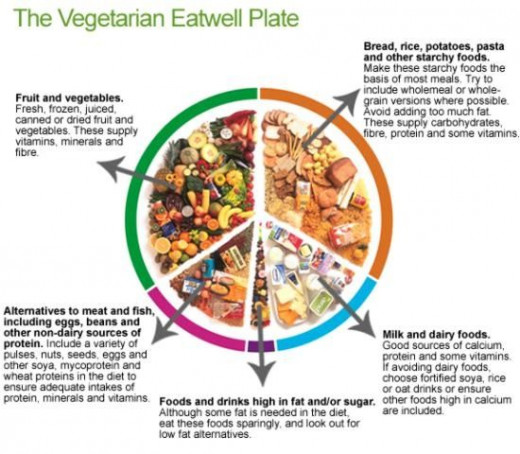
The Vegetarian Eatwell Plate from the Vegetarian Society.
The Vegetarian Eatwell Plate
The Vegetarian Eatwell Plate is the vegetarian version of the Eatwell Plate developed and used by the British Nutrition Foundation.
The Vegetarian Plate is divided into five different food groups.
- 1. Carbohydrates - Breads, Rice and Potatoes
- 2. Fruits and Vegetables
- 3. Alternative to Meat and Fish
- 4. Milk and Dairy
- 5. Food high in Fats and Sugar
How to Use the Vegetarian Eatwell Plate
The main healthy eating messages are the same for everybody. As part of a healthy balanced diet, we should all be trying to do the following:
For more information see The Vegetarian Eatwell Plate.
- Carbohydrates - Breads, Rice and Potatoes, Pasta and other Starchy Foods
These starch foods should be the basis of most meals. Try to include wholemeal or wholegrain versions when possible.
Avoid adding too much fat. These supply carbohydrates, fiver, protein and some vitamins.
- Fruits and Vegetables
Fresh, frozen, juiced, canned or dried fruit and vegetables.
These supply vitamins, minerals and fiber.
- Alternatives to Meat and Fish, including Eggs, Beans and Non-Dairy Sources of Protein
Incude a variety of legumes, nuts, seeds, eggs and other soy and wheat proteins in the diet.
These supply protein, minerals and vitamins
- Milk and Dairy
Low fat sources are best for milk and milk products
These are a good source of calcium, protein and some vitamins
- Food High in Fats and Sugar
Eat these foods sparingly and look for low fat options.
Tips to Follow the Vegetarian Eatwell Plate
The main healthy eating messages are the same for everybody. As part of a healthy balanced diet, we should all be trying to do the following:
For more information see The Vegetarian Eatwell Plate.
- Eat at least five portions of a variety of fruit and veggies every day
Be sure to choose fruit and veggies of different colors. Eat a mixture of cooked and fresh produce.
- Make a third of meals based on starchy foods. These include pasta, rice, cereals and legumes like beans, peas and lentils.
- Cut down on saturated fat.
Choose foods that are rich in unsaturated fat, such as vegetable oils (sunflower, canola and olive oil), avocados, nuts and seeds.
- Grill, bake, poach, boil, steam, dry-fry or microwave instead of frying or roasting in oil.
- Eat a variety of protein foods such as legumes, soy, quinoa, tofu, dairy products, eggs, nuts and seeds.
- Limit the amount of add sugars in foods and beverages.
- Reduce your salt intake to under 1500 mg a day.
Do not add salt to your food at the table.
- Be sure to drink 6 to 8 glasses of water a day.
Drink more water if you exercise.
More on the The Vegetarian Eatwell Plate
- The Vegetarian Eatwell plate
The Vegetarian Eatwell Plate is a great way to find out whether you are eating the mix of foods. The plate shows each food group, protein, carbohydrates, fats and fruit & vegetables as a proportion of a balanced diet. - Health and Nutrition
Guide to vegetarian nutrition and health information. Everyone wants to be sure that they are eating a healthy diet. It has been demonstrated that vegetarian and vegan diets can meet the nutritional needs for people of all ages. - Information booklets available from the Vegetarian Society
A list of all the information booklets available to order free from the Vegetarian Society. Most can also be downloaded for free from their site.
Tips to Raise Vegetarian Children
Registered Dietitian Christine Marquette offers some great tips on how to raise children on a vegetarian diet. One key is to make sure that vegetarian children have a good quality source of protein on a daily basis.
Books on Raising Vegetarian Children
The Vegetarian Pyramid
Vegetarian Food Pyramid
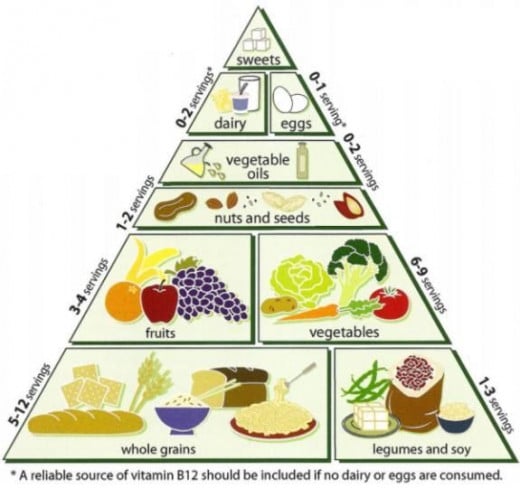
Guidelines for Healthful Vegetarian Diets
The Loma Linda University, School of Public Health, Department of Nutrition developed a four page brochure for the Vegetarian Food Pyramid to give people an idea of the types of foods and the number of servings for different food groups. They break the food groups into dairy, eggs, vegetable oils, nuts and seeds, fruits, vegetables, whole grains and legumes and soy.
In addition, they offer the following guidelines for maintaining a healthful vegetarian diet along with a list of Vegetarian FAQ's in their helpful PDF file, The Vegetarian Food Pyramid available on the Vegetarian Nutrition website.
- Variety of plant foods in abundance
- Emphasis on unrefined foods
- Healthy range of fat intake
- Adquate water and other fluids
- Regular physical activity
- Moderate sunlight exposure
Vegetarian Food Pyramid
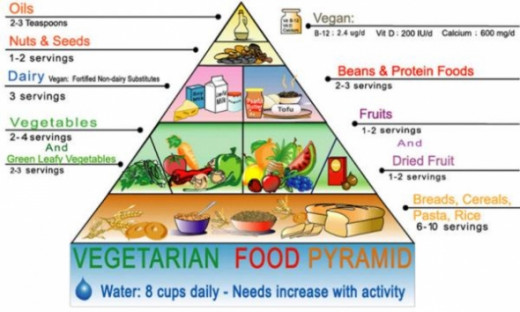
Special Nutritional Needs of Vegans
In the Modified Food Guide Pyramid for Lactovegetarians and Vegans version of the Vegetarian Food Pyramid, the designers have noted special dietary needs for Vegans.
Vegans need to be carefully selecting foods that are good sources of protein, iron, zinc, vitamin B12, vitamin D and calcium, as found in fortified breakfast cereals and nondairy fortified milk options. If they are not getting enough in their diet, daily supplements of vitamin B12, vitamin D and calcium may be needed in the amounts listed below.
Source: Modified Food Guide Pyramid for Lactovegetarians and Vegans
- Vitamin B12
- Vitamin D
- Calcium
Resource for the Modified Food Guide Pyramid for Vegans
Venti C, Johnston C. Modified Food Guide Pyramid for Lactovegetarians and Vegans. J. Nutr. 132:1050-1054, 2002.
- Modified Food Guide Pyramid for Lactovegetarians and Vegans
Haddad et al. (16 ) provided a conceptual framework for the development of a new and unique food guide for vegetarians based on the input from an international panel of experts in vegetarian nutrition. These experts concurred that the guide should be
Resources on Vegetarian and Vegan Diets
- Vegetarian diet: How to get the best nutrition - MayoClinic.com
A vegetarian diet can meet your nutritional needs if you follow this helpful guide. - Eating Guidelines for Lacto-Ovo Vegetarians
Information about a Lacto-Ovo Vegetarian Diet from the Dietitians of Canada. - Eating Guidelines for Vegans
Information about a Vegan Diet from the Dietitians of Canada. - Vegetarian Diet: MedlinePlus
A vegetarian diet focuses on plants for food. These include fruits, vegetables, dried beans and peas, grains, seeds and nuts. There is no single type of vegetarian diet. - Vegetarianism: MedlinePlus Medical Encyclopedia
A vegetarian diet is a meal plan that contains mostly plants, such as vegetables, fruits, whole grains, legumes, seeds, and nuts, with little or no animal products. - The Vegetarian Eatwell plate
The Vegetarian Eatwell Plate is a great way to find out whether you are eating the mix of foods. The plate shows each food group, protein, carbohydrates, fats and fruit & vegetables as a proportion of a balanced diet. - The Oldways Vegetarian Diet Pyramid | Oldways
The Vegetarian Diet Pyramid is the fourth diet pyramid released by Oldways and the Harvard School of Public Health. - Becoming a Vegetarian
People choose vegetarianism for a variety of reasons. This article describes different types of vegetarianism and provides advice on ways for vegetarians to get all the nutrients they need. - Vegetarian Brochure
Nutrition Topics Brochures from the University of New Hampshire. - Position Statement on Vegetarian Diet
The Seventh-day Adventist Position Statement on Vegetarian Diets - Is it possible to get all the nutrients I need on a vegetarian diet?
Dietitians of Canada answer the question, "Is it possible to get all the nutrients I need on a vegetarian diet?"
Books on Eating a Vegetarian Diet
MyPlate Posters, Stickers and More
"Teach Nutrition" on Zazzle came out of my need for customized MyPlate materials that I could use when teaching nutrition. After MyPlate was relea...
MyPlate - The New Food Pyramid
In June 2011 the Department of Agriculture introduced the new food icon, MyPlate.gov as a new food guide. With this new guide educators and health care provi...
MyPlate Coloring Pages
With the introduction of the MyPlate food icon, the USDA also developed new teaching tools and plate coloring pages with the MyPlate image to go along with t...
MyPlate for Vegetarians
The new food representation guide, MyPlate released in June 2011 offers something that the old MyPyramid did not, namely food choices and information for veg...
More Lenses on Food Pyramids, Plates and Healthy Eating
- My Plate - The New Food Pyramid
In June 2011 the Department of Agriculture introduced the new food icon, MyPlate as a new food guide. With this new guide educators and health care provides now need to learn new ways of teaching students and educating patients and clients about how - MyPlate Coloring Pages
With the introduction of the MyPlate food icon, the USDA has also developed new teaching tools and plate coloring pages with the new MyPlate image.
What do you think about the new Vegetarian Plate?












